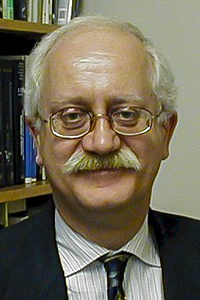Tidlegare gjesteforelesninger og seminarer - Side 50
By David Houle from Florida State University
Tom Ayres (Center for Astrophysics & Space Astronomy, University of Colorado at Boulder)
The Skolem Lecturer of 2016 will be Stewart Shapiro from Ohio State University
Dr. Nacira Agram (University of Biskra, Algeria) gives a lecture with the title: Stochastic optimal control of McKean-Vlasov equations with anticipating law.
Guest lecture by Dr. Christian Pfeifer, Christian Albrechts University, Kiel, Germany.
Sverre Holm, professor, Institutt for informatikk / Dept. of Informatics
John Christian Ottem, UiO, gives the Seminar in Algebra and Algebraic Geometry:
Title: Moduli of K3s via Global Torelli
Abstract: I'll give a brief account of the Torelli theorems and the construction of the moduli space of K3 surfaces
Abhik Ghosh (Dept. of Biostatistics, UiO) will give a seminar in the lunch area, 8th floor Niels Henrik Abels hus at 14:15.
We will have a new “mingle” meeting on Friday at 11.15 (as usual). The main attraction will be Ingunn Wehus and Signe Riemer-Sorensen.
Otherwise there will be updates from Kristine and Viggo on the running of the institute. But fear not, there will also be plenty of time for informal chat and eating of cake.
All are welcome to the lobby on the first floor.
Alessandro Oneto (Stockholm) gives the Seminar in Algebra and Algebraic Geometry:
Ideals of points and Waring problems for polynomials
Abstract: This talk addresses some of the fundamental barriers in the theory of computations. Many computational problems can be solved as follows: a sequence of approximations is created by an algorithm, and the solution to the problem is the limit of this sequence (think about computing eigenvalues of a matrix for example). However, as we demonstrate, for several basic problems in computations such as computing spectra of operators, solutions to inverse problems, roots of polynomials using rational maps, solutions to convex optimization problems, imaging problems etc. such a procedure based on one limit is impossible. Yet, one can compute solutions to these problems, but only by using several limits. This may come as a surprise, however, this touches onto the boundaries of computational mathematics. To analyze this phenomenon we use the Solvability Complexity Index (SCI). The SCI is the smallest number of limits needed in order to compute a desired quantity. The SCI phenomenon is independent of the axiomatic setup and hence any theory aiming at establishing the foundations of computational mathematics will have to include the so called SCI Hierarchy. We will specifically discuss the vast amount of classification problems in this non-collapsing complexity/computability hierarchy that occur in inverse problems, compressed sensing problems, l1 and TV optimization problems, spectral problems, PDEs and computational mathematics in general.
Ekstraforelesning fra årets Hasselforeleser. Tittel: Seeing, Measuring and Understanding Vesicular Exocytosis of Neurotransmitters with “Artificial Synapses”
Tittel: Finding Out Egyptian Gods’ Secret Using Micro-Analytical Chemistry: Biomedical Properties of Egyptian Black Makeup Revealed by Microamperometry at Single Cells
Martin BUCHER, Directeur de Recherche, CNRS, Paris
What makes us us? Why do we react and process things differently, and how do things we experience shape us? And have you heard about the epigenetic clock that can predict your age? How does it work, and how can the epigenetic clock be used to study neuropsychiatric disorders? Find out more about what happens to epigenetic marks in the initial stages of mouse development.
Velkommen på likestillingsseminar på MN-fakultetet 9. mai.
Ainar Drews, PhD , ITA
Abstract: In a recent work with R. Conti (La Sapienza Univ., Rome), we have introduced a notion of positive definiteness for certain functions associated to a (unital, discrete) C*-dynamical system. We will sketch the proof of a Gelfand-Raikov type theorem for such functions and use it to construct complete positive maps on the full and the reduced C*-crossed products of the system. We will also explain how a natural definition of amenability for C*-dynamical systems emerges from our work.
Abstract:
Marit Sandstad, Postodoctoral fellow NORDITA
Nordområdeutvalget inviterer til seminar om tverrfaglighet i nordområdeforskningen i samarbeid med Det matematisk-naturvitenskapelige fakultet. Dette er det første i en rekke miniseminarer med fokus på nordområdene.
By Fabienne Krauer from Institute of Social and Preventive Medicine (ISPM), University of Bern, Switzerland
Timo Koski (Dept. of Mathematics, Royal Institute of Technology, Stockholm) will give a seminar in the lunch area, 8th floor Niels Henrik Abels hus at 14:15.
Jack Carlyle, Postdoc , ITA
A Scandinavian Gathering Around Remarkable Discrete Mathematics



